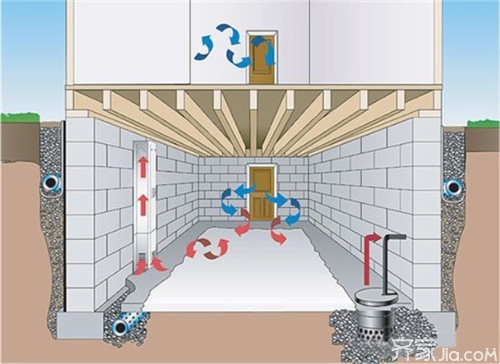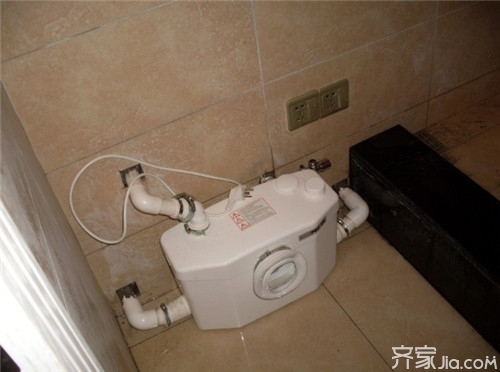Building a bathroom in the basement of a building or villa is often encountered during process design. At this time, regardless of the number of bathroom fixtures installed in the bathroom, there are two common drainage methods: one is to set a sump below the basement floor to collect sewage from sanitary ware and then use a submersible sewage pump to raise the row. To outdoor sewage pump wells. Another method is to drain the toilet sewage into an outdoor underground sewage pumping well and use a submersible sewage pump to raise the sewage inspection well discharged into the vicinity of the pump well. Then let's take a look at the basement drainage system design and basement drain installation method.

Basement drainage system design
A Basement Drainage - This refers to drainage in the basement ditch (or underdrain) drainage.
I. Water collection pit
Technical regulations
1 The number and location of the collection pits should meet the function and design requirements;
3 The depth of the sump should meet the design requirements and function, and the installation height of the sewage pump (the sewage pump is usually a vertical installation);
4 The depth of steel is more than 1.5m should be set to repair steel ladder;
5 The sump cover plate should be embossed steel cover plate or polymer composite resin cover plate.
2, construction regulations
The geometric dimensions are square; the inner wall is smooth and flat; the verticality must not be greater than 5mm; the pit is clean and there must be no construction waste, sundries, sludge, etc.
Second, the drainage ditch
Technical regulations
1 According to the requirements of the drawings, the width of the negative ditch of the second level drainage ditch shall be 300mm, and the width of the negative ditch shall be 100mm;;
2 The slope of the drainage ditch should be considered not less than 2 to 3 çºµå‘ in the longitudinal direction (the slope in the drainage ditch on the drive lane is designed and constructed) and drained to the sump;
3 Cut-off drains shall be provided at the junction line of the lower basement cars (including bicycles, motorcycles, etc.) at the end of the ramp. This ditch should be an underdrain, and the surface of the ditch should be covered with a polymer composite resin cover plate (a heavy-duty cover plate on the car track).
2. Technical measures
1 Determine the drainage ditch positioning point according to the construction drawings.
2 The steel pipe is installed by ground construction workers in a way that extends the meter according to the positioning point.
3 The installation height of the channel is referenced to the floor thickness, and the cable is corrected and reinforced.
3, construction regulations
1 Drainage gutters should be straight, wide and narrow, and have correct slope (no slopes, no water);
2 The groove is smooth and the curvature is the same;
3 The trench cover plate should be laid straight, flat, stable, and not damaged;
4 Ditch cover plate should be customized at the corner, abnormal shape or not at the modulus, etc. It is strictly forbidden to mechanically assemble.
Third, the floor (floor)
1. Technical regulations
The thickness of the negative second floor (building) is 200mm, and the thickness of the negative floor (building) is 100mm. The drainage slope should be set. When there is no design requirement, it should be 1~2c/o to the peripheral drainage.
2. Construction regulations
Surface (floor) surface is flat, no empty drum cracking, the color is basically the same and the surface is not peeling, sanding phenomenon, reasonable and meet the norms, standards (not more than 36m2), the slope is correct, the surface no water and Fall backwards.
3. Requirements
1. Prior to construction, technical disclosure should be done well and records should be made.
2, before the construction should be done in advance model, sample acceptance after the large area of ​​construction can be carried out. All professional engineers of the model acceptance construction unit, supervision unit, and Party A project department shall participate.
3, materials approach should be done inspection and acceptance work, after acceptance can be used on the project.
4. After completion of each procedure, it shall be submitted to the project department, supervision unit, and the project department of Party A for inspection and acceptance. After the acceptance, the next process may be carried out.

Basement drain installation method
Indoor drainage pipe installation
Pipe fittings and pipes: Pipes and fittings are to comply with the requirements of the design and construction specifications. Pipes that pass through walls of underground outdoor walls or underground structures shall be waterproofed and waterproof sleeves shall be provided.
Pipes should be avoided where they may be crushed by heavy objects. The slope of the drainage pipeline should meet the design requirements and the positive and negative errors must not exceed one-third of the design requirements. The connection of the horizontal pipe and the horizontal pipe of the drainage pipe shall be 45 degrees three-way or 45-degree four-way and 90-degree diagonal four-way. The connection between the riser and the discharge and the end of the pipe is preferably two 45-degree bends or a 90-degree bend with a bend radius not less than four times the pipe diameter.
Basement drain inspection opening
In the riser of the domestic sewage pipeline, an inspection opening is provided on each floor, but inspection openings must be provided on the lowest floor and the highest level of sanitary appliances. Sweeps shall be provided at the sewer cross pipe connecting 2 or more toilets or 3 or more sanitary appliances. In a horizontal cross-section pipe with a corner angle of less than 135 degrees, an inspection opening or a sweeping opening shall be provided. In the straight section of the sewage cross pipe, the inspection opening shall be set at the distance specified in the “construction specificationâ€. Checkpoints for drainage pipelines buried underground or under the floor should be located at the inspection wells. The bottom elevation shall be level with the flange of the inspection opening, and the bottom surface shall have a slope of 0.5 slope towards the inspection opening. [basement drain]
Basement drains considerations
Buried cast iron pipe, when the design is not required, it should be brushed twice to prevent corrosion. Hooks or clamps on the drain pipe should be fixed on the load-bearing structure. Fixture spacing: The cross tube shall not be larger than 2M, the standpipe may not be larger than 3M, and when the height of the layer is less than or equal to 4M, the standpipe may be fitted with a fastener. Concealed or buried drainage pipelines must be well-watered prior to concealment, and their irrigation height should not be lower than the ground floor height. After 15 minutes of full water, continue filling for 5 minutes and the liquid level does not drop to pass. After the rainwater pipe is installed, the irrigation test should be done. The irrigation height must reach the rainwater funnel at the top of each riser.
Finished product protection: Installed floor drains and toilet drainage pipes are sealed to prevent debris from falling into the pipes and causing blockages or poor water flow.
Summary: Information on the design of basement drainage systems and the installation of basement drains was introduced here. I hope this article will be helpful to everyone. If you still have something you don't understand, you can leave a message to Xiaobian at the bottom. We will answer your questions as soon as possible.
basement
Alloy Shackle,Anchor Shackle,Marine Shackle, Hot Dip Galvanized Shackle
Shandong Shenli Rigging Co.,LTD. , https://www.shenliriggingcn.com